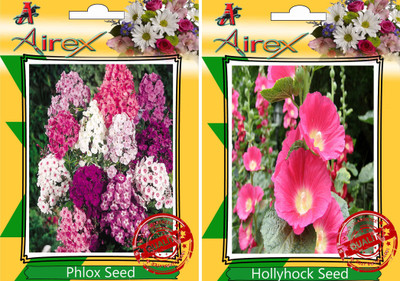Airex Phlox, Hollyhock Seed(25 per packet)
Quick Overview
Product Price Comparison
Phlox Flower Seeds:Description:Phlox are quintessential garden classics relied on for generations to provide bushy clumps of fragrant color in a wide range of mix and match shades. These flowers are also excellent for easy bouquets; just snip a half dozen big flower heads, drop them in a medium to large vase of water, add a few fern or hosta leaves for greenery and youŌĆÖre done.Learning how to plant and care for creeping phlox is quite simple. The plant has an easy going nature and thrives in a variety of conditions. Almost any soil is suitable for growing creeping phlox as long as it is in full sun to partial shade. For best results, however, plant it in a sunny location where soils are moist but well drained.Even established plants should have supplemental watering in hot summer periods and plants along rockeries may show signs of scorching due to the hot surroundings.The stems can be cut back after flowering to promote a second bloom. Care of creeping phlox may also include cutting the plant back in late winter to allow for rejuvenation and to produce young, more compact stems. Hollyhock Flower Seeds:Description:A group of well grown Hollyhocks in bloom is worth going to see. It is really the color that we look for, because the leaves are large, coarse and grow mostly in clumps at the base of the plant. The long spikes of flowers grow from. 5 feet to 8 feet high and there are usually from five to nine blossoms in bloom on each well grown stalk. The average size is about 2 inches or 3 inches across, but 5-inch blooms can be had if good attention is given. The colors range from white to almost black and include shades of pink, flesh, rose-pink, salmon-rose, golden yellow, canary-yellow, dark red, purple-crimson, dark maroon, white and combinations of practically all these colors with either white centers or white margins. Linnaeus, who named this plant, used both Alcea (Latin form) and Althea(Greek form) from the Greek word for 'to cure'.


